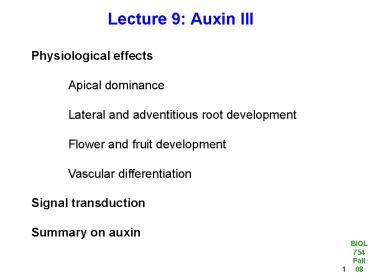Lecture 9: Auxin III PowerPoint PPT Presentation
1 / 18
Title: Lecture 9: Auxin III
1
Lecture 9 Auxin III
Physiological effects Apical
dominance Lateral and adventitious root
development Flower and fruit development Vascu
lar differentiation Signal transduction Summary
on auxin
2
Auxin regulates apical dominance
Apical dominance the growing apical bud
inhibits the growth of
lateral (axillary) buds
Phaseolus vulgaris (bean)
Removal of apical/ terminal bud induces growth of
axillary buds
Applying IAA to cut surface prevents outgrowth of
axillary buds
Axillary buds are suppressed because of apical
dominance
3
Auxin promotes the formation of lateral and
adventitious roots
Lateral roots
- Found above the elongation zone - Originate
from cells in the pericycle - Auxin stimulates
the cells to divide - Dividing cells gradually
form into a root apex - Lateral root grows
through the root cortex and epidermis
Adventitious roots
- Originating from non-root tissue
- From clusters of mature cells that renew their
cell - division activity
- Dividing cells develop into root apical meristem
- similar to lateral roots
- Auxin stimulation of adventitious roots useful
for - propagation of plants by cuttings
4
Auxin promotes the formation of lateral and
adventitious roots
WT
alf1 aberrant lateral root formation
Extreme proliferation of lateral and adventitious
roots
5
Genes involved in regulating lateral root
formation
ALF1
ALF4
ALF3
Defective in development of lateral-root
primordia into mature lateral roots
6
A model of lateral root formation
IAA transported acropetally (toward the tip) in
stele is required to initiate cell division in
pericycle
IAA is required to promote cell division and
maintain cell viability in developing lateral root
7
Auxin transport regulates floral bud development
Treatment of plants with auxin inhibitor NPA
causes abnormal floral development (similar to
pin1 mutant). Floral meristem depends on auxin
being transported to it from subapical tissue.
In absence of efflux carrier, meristem is
starved for auxin and normal phyllotaxis and
floral development are disrupted.
8
Auxin promotes fruit development
Auxin is produced in pollen, endosperm, and
embryo of developing seeds.
Growth of fruit is regulated by auxin produced
by seeds, the achenes.
9
Auxin induces vascular differentiation
10
Auxin signal transduction pathway
ABP1 AUXIN BINDING PROTEIN abp1 knockout
mutants are lethal primarily localized on ER,
small amount present on plasma membrane Remains
to be determined whether ABP57 from rice is
involved in signal transduction TIR1
TRANSPORT INHIBITOR RESPONSE1, breakthrough
discovery (Dharmasiri et al. 2005
Nature 435 441, Kepinski and Leyser 2005 Nature
435 446) binds auxin F-Box protein involved in
ubiquitin-mediated protein degradation Additiona
l receptors? Auxin Response Factors (ARF)
transcriptional activators by binding to the
auxin response element TGTCTC present in the
promoters of auxin response proteins Calcium
may be involved, as auxin increases free level of
calcium in cell pH auxin induces decrease in
cytoplasmatic pH MAP kinases phosphorylating
proteins that ultimately activate transcription
factors - auxin stimulates cell cycle
activity by stimulating synthesis of the
major cyclin-dependent protein kinase CDC2
(cell division cycle 2)
11
Auxin signal transduction pathways Genes
regulated by auxin
Genes involved in auxin-regulated growth and
development AUX/IAA gene family (short-lived
transcription factors) SAUR gene family
(gravitropism) GH3 gene family (auxin response
proteins, ARF, containing auxin response element
TGTCTC)
Stress response genes Genes encoding
glutathione S-transferase (GSTs) Genes encoding
1-aminocyclopropane-1-carboxylic acid (ACC)
synthase, the key enzyme in ethylene biosynthesis
ARFs form dimers by binding to response element
arranged in a palindrome
- Early auxin-responsive genes
- - activated by pre-existing transcription factors
- Cannot be blocked by protein synthesis
inhibitors - may encode proteins that regulate transcription
of secondary response genes
12
Auxin signal transduction pathway current model
No
Hormone
Receptor
Transcriptional repressors
Transcriptional activators
Woodward and Bartel 2005 Plant Cell 17 2425
13
The auxin receptor
14
Auxin signal transduction - Repression
15
Auxin signal transduction - Activation
16
Auxin signal transduction - Potentiation
17
Summary AUXIN
What is auxin? How and where is auxin
synthesized? How is auxin transported in the
plant? What experiments could you run to show
auxin transport? What are important components
(proteins) of auxin transport? How do cells
grow? How do plants respond to light? How do
plants respond to gravity? Which developmental
processes are affected by auxin? What is our
current understanding of auxin signal
transduction?
18
Reading assignment I
Objectives of the reading assignment are - Make
you familiar with the primary literature in the
field. - Review the publication and identify
novel aspects of the research presented in the
paper. The paper should deal with developmental
processes and must not use Arabidopsis as a
research object. - How does this paper advance
our understanding of plant developmental
processes? 1. Reading assignment - Present the
major findings of the paper in class in form of a
short presentation (15 5 min discussion) and
discuss the results in class. - Summarize the
main results of the paper and discuss whether
they support the authors hypotheses. - Are
the conclusions justified? - Emphasize
interesting techniques used to answer the
questions raised in the paper. - Your suggestions
for improvements and/or other approaches.

